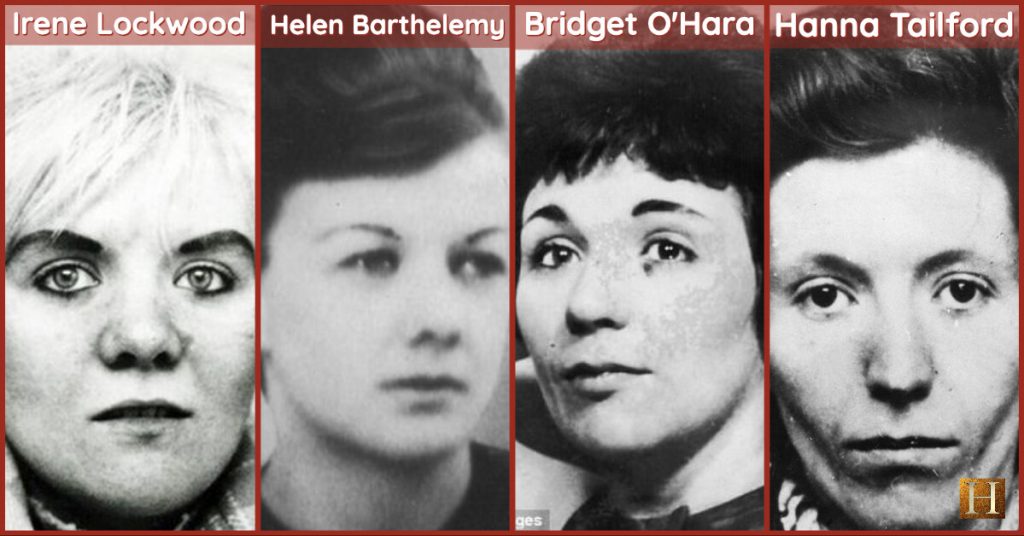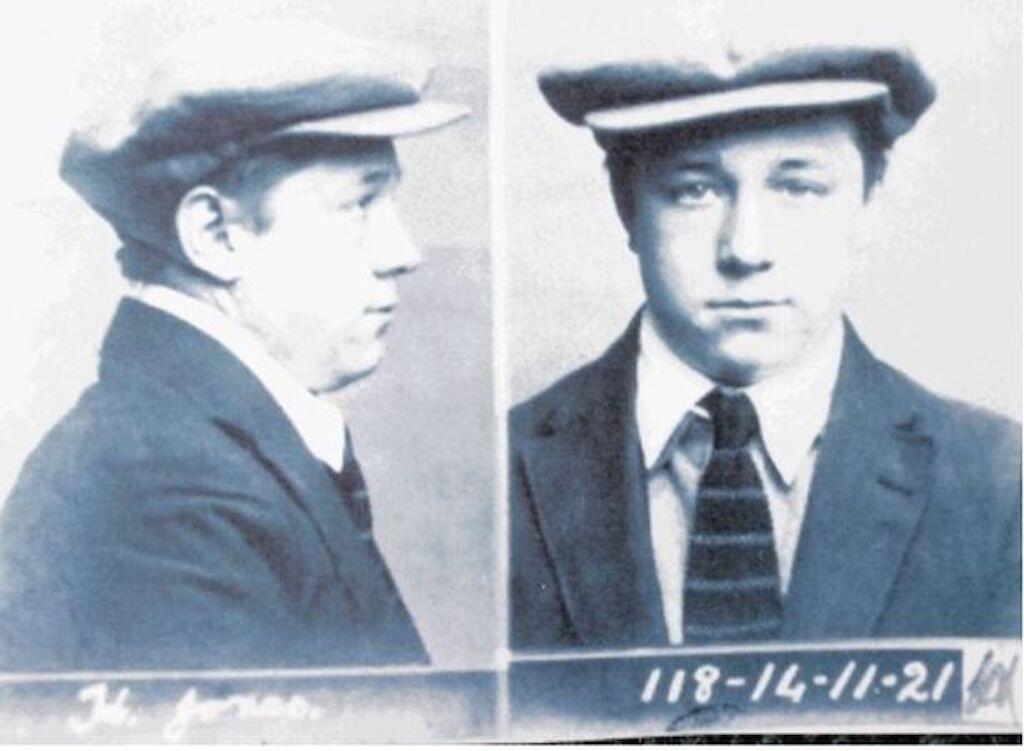He struck seemingly from out of nowhere. A small area of London lived in fear that he would kill again. Women lived in fear of becoming this monster’s next victim. Several prostitutes were slain in secret and left on display in gruesome displays of power and control. This is the story of the most notorious unknown serial killer that you’ve never heard of: Jack the Stripper.
About Jack the Stripper
Like his more infamous namesake, this Jack struck at least six times in all. Some believe he killed up to eight women. Jack the Stripper’s death toll is an ambiguous one as two of his supposed victims do not match the Modus Operandi of the other six. All victims were discovered in the Hammersmith district of London, in or around the River Thames over the course of a 12 month period from 1964-1965. Each body was discovered unclothed.
Victims

Some of the victims of the Hammersmith Nude Murders.
Hannah Tailford – Hannah Tailford was born into a Lancashire mining family. She was found close to the Hammersmith Bridge on 2 February 1964. Several teeth were missing and her underwear had been forced down her throat. She was also strangled.
Irene Lockwood – Irene Lockwood was discovered just over two months later on 8 April. She was found not too far from the spot Hannah was found. Police established that both deaths were linked, along with a third, Elizabeth Figg. A local caretaker, Kenneth Archibald confessed to Irene’s murder at the end of April but owing to inconsistencies in his account, it was dismissed as credible.
Helen Barthelemy – Helen Barthelemy was only 22 years old when she was found on 24 April. This time though, her body was discovered in an alleyway in Brentford. It was this crime scene that gave Detectives their first real clue. Specks of paint were discovered close to the body which investigators attributed to the production of motor vehicles. Detectives believed their suspect was a paint-sprayer.
Mary Flemming – When Mary Flemming was discovered on 14 July in an open street in Chiswick. Many locals reported hearing a vehicle – probably a car – reversing down the street shortly before the discovery of her body. More specks of paint were discovered at the scene.
Frances Brown – Frances Brown was last seen alive by her friend, Kim Taylor, on 23 October. Just over a month later, on 25 November, she was discovered in an alleyway in Kensington. Taylor was able to provide a composite of the man that picked her up, as well as a description of the car he was driving. Kim thought it was either a Ford Zephyr or a Zodiac.
Bridget “Bridie” O’Hara – Jack’s last known victim was Bridget O’Hara. Known as Bridie, she was found behind the Heron Trading Estate inside a shed. More paint traces were found at the scene. There were signs that she had been stored in a warm environment, perhaps as a result of the transformer’s presence.
Other Possible Victims
Elizabeth Figg’s murder predated the Stripper’s official victims by five years, being discovered on 17 June 1959. Her murder is linked to the others as she was found near the River Thames in Chiswick. She was strangled.
Another possible victim is Gwynneth Rees. She also had several teeth missing and was strangled with a ligature. Her body was found on a rubbish tip not far from the Thames in 1963.
Hammersmith Nude Murders Case
The police never officially solved the Hammersmith Nude Murders, as it came to be known. But some interesting leads developed. Hannah Tailford and Frances Brown were said to be peripherally involved in the Profumo Affair of 1963. This scandal involved a sexual relationship between John Profumo, UK’s Secretary of State of War and Christine Keeler, a 19-year-old aspiring model.
Richard Chase – The Vampire of Sacramento
Other Hammersmith Nude Murder victims allegedly had some involvement with the pornographic movie scene and were known to one another. Perhaps their killer as well.

Chief Inspector John du Rose was the detective in charge of the Hammersmith Nude Murders case of 1964-1965. Photo by Daily Mirror/Mirrorpix/Mirrorpix
Chief Superintendent John Du Rose led the investigation into the deaths. It was said that during his investigation, 7000 suspects were brought in for questioning. At a series of news conferences, he stated that the suspects had been narrowed to just 20, then halved and finally, just a trio of suspects remained. After the initial conference, Jack the Stripper’s reign of terror was over. He did not kill again.
The paint specks, found on four of the victims, ultimately led to an abandoned factory on Heron Trading Estate. O’Hara’s body was discovered not far from this location.
Suspect #1 Mungo Ireland
Du Rose favored one suspect over all others though. During a BBC interview in 1970, Du Rose formally identified Scottish security guard Mungo Ireland as the man he believed to be Jack the Stripper. He never identified Ireland by name, instead referring to him as ‘Big John’. Du Rose stated Ireland became a suspect after the murder of Bridget O’Hara. Like the specks of paint, Ireland was linked to the Heron Trading Estate. Ireland took his own life not long afterward. He left a note stating:
“I cannot stick it any longer. To save you and the police looking for me, I’ll be in the garage.”
Du Rose perhaps influenced keen amateur detectives and the public alike with his honest opinions. But more recent evidence does suggest Ireland was in Scotland at the time of Bridget’s death.
Suspect #2 Freddie Mills

Ex-Gangster Jimmy Tippett Jr singled out Boxer Freddie Mills as Jack the Stripper.
More recent suspects have come to light. One of the more interesting of these is British Light-Heavyweight boxing champion Freddie Mills. Ex-Gangster Jimmy Tippett Jr. suggested Freddie committed the murders while conducting research on gang activity in London. Tippett stated:
[blockquote align=”none” author=”Jimmy Tippett Jr.”]I have spoken to famous figures in the underworld and senior police officers in Scotland Yard, and I am convinced Freddie Mills was the killer. Contrary to his public image, Mills was a sexually warped sadist who enjoyed inflicting pain.[/blockquote]
His suicide in 1965 did coincide with the end of the Hammersmith Nude Murders. However, law enforcement never substantiated this claim.
Suspect #3 Harold Jones

Mug shot of 15-year-old Harold Jones following the murder of two young girls.
The Crime and Investigation channel show Fred Dinenage Murder Casebook proposed a more interesting hypothesis. The show devoted an episode to Harold Jones, a welsh teenager convicted of the double murder of two young girls in 1921. As a juvenile, he escaped the death penalty due to his age. Twenty years into his life sentence, he was released on good behavior. Jones subsequently surfaced in Fulham, southwest London in 1947. There were similarities between the 1921 double murders and the Jack the Stripper murders: no signs of a sexual assault took place, but all victims suffered terrible violence.
Who was Jack the Stripper? A security guard? Former boxing champion? Welsh child killer? An obsessed Jack the Ripper fanatic? Chances are his identity will never be known.